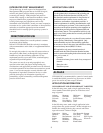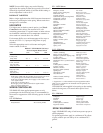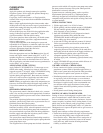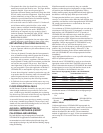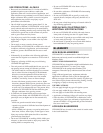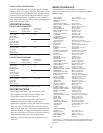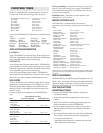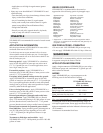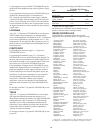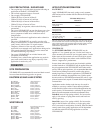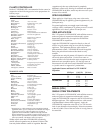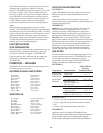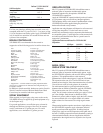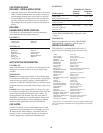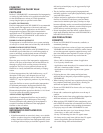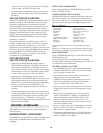
For preemergence use only, DuPont™ VELPAR® DF may be
applied with aerial equipment using at least 10 gallons of spray
per acre.
For spot treatments of emerged weeds, VELPAR® DF may be
applied with a knapsack sprayer in concentrations of
0.6 - 4.8 pounds per 100 gallons of water. Apply a sufficient
volume to thoroughly wet weed foliage, but do not exceed 40
gallons of spray per treated acre. Use the lower concentrations
on coarse-textured soils that are low in organic matter, and use
the higher concentrations on fine-textured soils that are high in
organic matter.
LOUISIANA
Apply 2/3 - 1 2/10 pound of VELPAR® DF per acre broadcast
in the fall before sugarcane emerges or in the spring before
active cane tillering begins. Fall treatments of 2/3 - 1 2/10 pound
per acre may be followed by a spring treatment of 2/3 - 1 2/10
pound per acre. Do not apply more than 2 pound per year. Use
the lower rates on coarse textured soils and the higher rates on
fine textured soils.
PUERTO RICO
For preemergence treatments, apply 1/3 - 2/3 pound of
VELPAR® DF per acre.
For postemergence treatments, apply 1/3 - 2/3 pound of
VELPAR® DF per acre to weeds after they have emerged. Use
the lower rates on coarse-textured soils and the higher rates on
fine-textured soils (high in clay or organic matter). Each ratoon
may receive up to 2/3 pound of VELPAR® DF per acre.
For spot treatment of emerged weeds, VELPAR® DF may be
applied with a knapsack sprayer in concentrations of 1/3 - 2/3
pound per 100 gallons of water. Apply a sufficient volume to
wet the weed foliage. Do not exceed 100 gallons of spray per
treated acre. Use the lower concentration on coarse-textured
soils and the higher concentration on fine-textured soils.
Note: Since it is difficult to calibrate “spot” knapsack
applications, extra care must be taken not to exceed the rate
equivalent of the maximum of 2/3 pound VELPAR® DF per
acre.
Do not apply more than 1 1/3 pound of VELPAR® DF per acre
per crop season.
TEXAS
Apply 2/3 - 2 1/3 pound of VELPAR® DF per acre. On plant
cane, apply the herbicide before the cane emerges or as a
directed layby treatment. On stubble cane, apply VELPAR® DF
preemergence (up to the 3-leaf stage) or as a directed layby
treatment. Apre- or early postemergence treatment may be
followed by a layby treatment, provided at least 60 days have
elapsed and 3 inches of rainfall or sprinkler irrigation have
occurred since the first treatment.
Do not apply more than 2 1/3 pound of VELPAR® DF per acre
per season.
Use the following rates according to the different soil textures:
VELPAR® DF (Lb/Acre)
Soils Preemergence + Layby
Coarse
Texture
*
Sandy loam 1/3 1/3
Medium
Texture
Loam, silt loam 9/10 9/10
Fine
Texture
Clay loam 1 1/3 1 1/3
*With at least 2% organic matter
On dormant cane, a surfactant may be added to the spray
mixture to increase control of emerged weeds.
WEEDS CONTROLLED
VELPAR® DF is recommended for the control or
suppression of the following species in sugarcane crops:
* Suppression – a visible reduction in plant population and/or plant vigor
as compared to an untreated area and generally not accepted as control.
Ageratum, tropic* Ageratum conycoides
Alexandergrass Brachiaria plantaginea
Balsamapple Momordica charantia
Barnyardgrass Echinochloa crus-galli
Bermudagrass* Cynodon dactylon
Burnweed, American (fireweed) Erechtites hieracifolius
Chickweed, common Stellaria media
Crabgrass, large Digitaria sanguinalis
Crabgrass, smooth Digitaria ischaemum
Crotalaria, fuzzy Crotalaria incana
Crotalaria, showy Crotalaria spectabilis
Cuphea, tarweed Cuphea carthagenensis
Dallisgrass Paspalum dilatatum
Fingergrass, radiate Chloris radiata
Fingergrass, swollen Chloris barbata
Foxtail, bristly Setaria verticillata
Foxtail, yellow Setaria lutescens
Geranium, Carolina Geranium carolinianum
Goosegrass Elusine indica
Guineagrass Panicum maximum
Henbit Lamium amplexicaule
Itchgrass* Rottboellia cochinchinensis
Job’s-tears Coix lacryma
Johnsongrass (seedling) Sorghum halepense
Junglerice Echinochloa colonum
Lambsquarters, common Chenopodium album
Millet, Texas Panicum texanum
Morningglory, hairy Ipomoea pentaphylla
Morningglory, threelobe Ipomoea triloba
Mustard, wild Sinapis arvensis
Oxalis Oxalis spp
Paintbrush, Flora’s Emilia sonchifolia
Panicum, browntop Panicum fasciculatum
Paspalum, ricegrass Paspalum orbiculare
Paspalum, sour Paspalum conjugatum
Pigweed, redroot Amaranthus retroflexus
Pigweed, slender (green) Amaranthus viridus
Pigweed, smooth Amaranthus chlorostachys
Popolo Solanum sandwicense
Purslane, common Portulaca oleracea
Sandbur Cenchrus spp
Sensitive plant (hila hila) Mimosa spp
Signalgrass, broadleaf Brachiaria platyphylla
Sowthistle, common Sonchus oleraceus
Spanishneedles Bidens bipinnata
Sprangletop Leptochloa spp
Spurge, prostrate Euphorbia humistrata
Spurge, graceful Chamaesyce hypericifolia
Sunflower Helianthus spp
Vaseygrass Paspalum urvillei
Waltheria (hia loa) Waltheria spp
11



